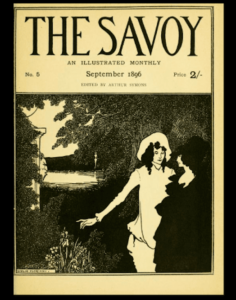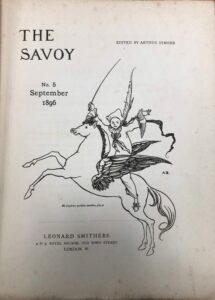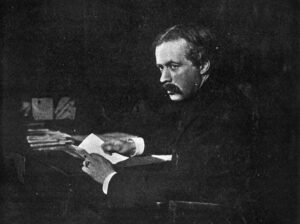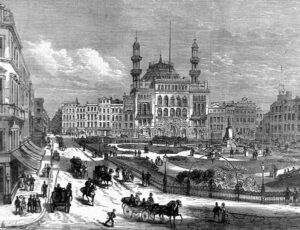Vulgarity, Scandal and Fairytales in Music Halls in “A Romance of Three Fools” by Ernest Rhys and “At the Alhambra: Impressions and Sensations” by Arthur Symons
©Loraine Illeperuma, Ryerson University 2018
Introduction

The Savoy was scandalous during its time because it was named after The Savoy hotel in London where Oscar Wilde’s famous affair occurred (Koenraad). Both Aubrey Beardsley and Arthur Symons had been ousted from the Yellow Book and as a retaliation, they started their own magazine, The Savoy (Koenraad). The two stories I will examine are “A Romance of Three Fools” written by Ernest Rhys and “At the Alhambra: Impressions and Sensations” written by Arthur Symons. Both stories, written in September 1896, were published in the fifth volume of The Savoy. Rhys uses satire in his work to connect fairytales and popular culture to their effects on music halls in the 1890s. While Arthur Symons’ “At the Alhambra: Impressions and Sensations” critiques and gives insight to a typical night in a music hall. Music halls are a key component in the 1890s as many individuals attended their events. Music halls during this period were seen as vulgar because the flaunting of women caused sexual excitement in the audience (Davis 112). Rhys’ work portrays how irony highlights The Savoy’s use of scandal and vulgarity while using fairy tales as a popular culture in music halls especially because music halls were seen as indecent during the time.
England in The 1890s

During the 1890s, many changes started to develop including the use of popular culture in narratives that the Late-Victorians used. The specific type of medium being music halls. The use of music halls is prevalent to the 1890s as many individuals watched the shows in them. Music halls were seen as cultural spaces where audiences could be influenced and antagonized (Faulk 112). Popular culture was followed by the working class as they created a space for themselves in the Late-Victorian period. Both Rhys and Symons’ writings illustrate the effects of fairy tales in the 1890s and its importance to understanding why many forms of entertainment included them. Rhys’ use of satire within his work illuminates the use of a fairy tale within a fairy tale. Many fairy tales in the 1890s were considered to be a way to adopt childlike feelings and, in turn, those feelings help the audience connect to a simpler time (Sumpter 225). This can be seen in both stories as Symons’ is centered around the folktale “Aladdin” and Rhys uses the fairy tale “Cinderella”. The use of fairy tales exposes illusions in their performances. By doing so, it also conveys these illusions, overall understanding the irony and vulgarity of popular culture in music halls. Rhys’ use of a fairy tale within a fairy tale exhibits the type of popular culture that was used to entertain the Late-Victorians. Fairy tales had a primal connection to one’s childhood, as a result, these assumptions were included in controversies in the 1890s (Sumpter 225). They ranged from national identity to the role of beauty (Sumpter 225). The use of fairy tales in the fin-de-Siecle literature is seen as a way of bringing the past to the future in a more complex way. As many individuals found music halls to be vulgar in nature, a childlike mindset was linked to the literary writings and experiments with fairy tales and played an entertaining role in the avant-garde debates (Sumpter 225). Although fairy tales have the notion of typically appealing to children, Rhys was able to take that idea and manifest it into a piece of literature that adults can follow and be entertained by. The use of music halls as popular culture maintained the way the working-class perceived their entertainment.
Scandals and the 1890s
One of the most prominent literature related scandals during the 1890s was Oscar Wilde’s trial. In Rhys’ story, Marie is a very elusive character. She hides where she goes and she uses men to her advantage. Rhys states “ [Marie] had always been rather mysterious in her comings and goings; but after thus she became more and more elusive, while the attentions of other admirers were nightly and more obvious” (58). This was the start of Marie’s scandal and Momus’ fairy tale thinking. In Symons’ story, he describes “[m]aquillage, to be attractive, [though it] must, of course, be unnecessary” (75). The use of makeup can also be seen as a taboo as this is what makes women at the time seem vulgar. They dress up to be in these plays and put on makeup to make themselves looks better. The act of dressing up was seen as an indecent act in the 1890s. While pointing out the sexual nature of the girls in the play Symons also states “there is the indiscretion of the costumes, meant to appeal to the senses” (77). The way these girls dress is deemed as a scandal as they accentuate their bodies for a role. Many ideas and dresses of actors and actresses were deemed vulgar in the 1890s might not be an issue in today’s society. The acts of how a woman dresses, homosexuality and makeup are not seen as something indecent today. It is accepted in many North American societies but the anti-liberal nature of the 1890s made it seem like gossip.

Sex and Music Halls
Symons’ uses his experience of the night at the Alhambra Theatre to explain the scramble as members of the ballet prepare for their big show. He states “[a]t once she seems to typify the sorceries and entanglements of what is most deliberately enticing in her sex” (77). The girl’s attitude and aura are what makes her seem sexy, as a result, making her seem improper in the eyes of the Late-Victorians. Specifically, her movements and the way she dresses makes her more sensual. The stage reclaims the working man by degrading feminization (Faulk 112). The use of fairy tales in popular culture affected the way Late-Victorians experienced art forms particularly facing music halls and their effects on the Victorians. The use of fairy tales transforms how entertainment is used to understand the world. This is due to the fact that Late-Victorian music halls can be identified as modern due to their development into an opinionated society (Faulk 5). By Rhys using fairy tale components in “A Romance of Three Fools,” he exhibits patterns in women that may not have been common during the time. Marie is able to entertain multiple men to get what she wants. As a result, this fairy tale like thinking is what drives Momus to look for her as he believes she is only flirting with him. Again, Rhys displays an indecent act that Marie had committed because she flirts with many men. As previously stated, the final years of the nineteenth century could be considered anti-liberal (Davis 111). These conservative views had many backlashes towards Oscar Wilde and his homosexuality as well as criticizing feminist reformers (Davis 111). This can be contributed to the indecency of the music halls and is present in the way writers present their stories from the 1890s. Oscar Wilde, who contributed to The Yellow Book, was a part of this movement as his homosexuality provoked individuals of the 1890s. Wilde’s homosexuality was seen as vulgar. Music halls were considered to be very salacious and indecent. The link between the Alhambra and “A Romance of Three Fools” is the popular culture of music halls and its use of fairy tale themes in their performances. Popular culture affected the ways the working-class people entertained themselves, while elites in the community tended to shun the idea of music halls because they were so vulgar. As in Symons’ writing, the dancer is a woman of substantial sensuality which is the turn of the vulgar world of the ballet (Carter 98). Symons identifies how sexual in nature music halls were. While exploring the ballet in many of his writing, he tends to objectify the ballerinas as a means of entertainment for men. These dancers are seen as human and distant as well as desirable (Carter 99). Symons sees the beauty in the dancers while illuminating the sexual nature of their profession. In this case, “A Romance of Three Fools” follows these themes of promiscuity and beauty as well. Rhys exploits Marie’s sexual nature without saying it is vulgar; instead he uses fairy tales to make his story suitable during this conservative time period.
Fairy Tales and their Effects on Late-Victorian Culture

Fairy tales are most commonly meant for children but during the 1890s many people read fairy tale literature. These works all fall into the fairy tale category because the characters go from “world” to “world”. The characters are forced to figure out how to find what they need and understand what is going on in that area at a particular time. This is presented in Rhys’s story as Momus (Jack) follows Marie throughout Europe. This is prevalent in “At the Alhambra: Impressions and Sensations” because Symons describes a night at the ballet and acts as if it is a new world and that sitting in different areas of the theatre changes the effect of how one understands the performance. These stories encompass themes of fairy tales differently but still have the same concept. In “A Romance of Three Fools” Momus wants his happy ending and to find the girl. Rhys writes a story that ironically and comically includes elements of fairy tales and fantasy into his work. Rhys, in this case, uses elements of fairy tales to present themes of illusions and lust through his writing. While Symons’ focuses on the themes and feelings of the time period he participates in a debatable dialogue about the significance of culture expertise (Faulk 4). His writing catered more to the elite class while the music halls were meant for the working-class. Many writers wrote about music halls as genuinely as possible as they were very fond of them as well as staying true to its proletarian form (Faulk 3). Both stories have a way of indicating how performance was used to entertain while bringing old and new world cultures to the stage, in this case using fairy tale content to bring alive entertainment in music halls and ballet. Fairy tales bring a certain level of innocence to the story. Yet the theme of promiscuity is still common in both works. Symons states in “At the Alhambra: Impressions and Sensations” “[t]he very phrase, painted women, has come to have an association of sin” (77). Symons goes on to say that the women’s jobs in a music hall have a symbolic corruption due to the “paint on her cheeks” (77). He critiques the conservative views of the Late-Victorians while Rhys uses it as a means to play on the impurity around music halls and women working in them. An example of this is using Marie’s elusive behaviour to bring a scandal like composition to the story. This follows the theme of scandal and lewdness that The Savoy produces.
Conclusion
The use of vulgarity and scandal in the issues of The Savoy are what make it interesting to the Late-Victorians. The use of a scandal or indecency seemed to be the reason music halls were so popular. Authors such as Rhys make these immoral acts seem rational because both authors use fairy tale analogies. The use of fairy tales helps individuals think of a simpler time as stated by Sumpter. Since fairy tales were becoming a prevalent idea during the 1890s many magazines like The Savoy were able to hide these lewd acts within the storylines. The use of scandal, in this case, can be seen as useful because it was able to put a spin on a story that might have been less interesting without it. Arthur Symons’ critiques the night at the ballet looking into it closely but still giving readers images of how the women of the ballet may seem indecent. Rhys illuminates scandal and vulgarity by using aspects from fairy tales to produce a story that is intriguing. Though, he is able to do it in a tasteful manner. Both authors display how indecency and scandal may have come to be in the 1890s continuing the theme that The Savoy advocates.
Works Cited
Carter, Alexandra. Dance and Dancers in the Victorian and Edwardian Music Hall Ballet. Ashgate Publishing Company , 2005.
Claes Koenraad. “Savoy (1896).” C19: The Nineteenth Century Index, Dictionary of Nineteenth Century Journalism , courses.ryerson.ca/d2l/le/content/192098/viewContent/2130606/View.
Davis, Tracy C. “Chapter 7: Indecency and Vigilance in the Music Halls.” British Theatre in the 1890s: Essays on Drama and the Stage, edited by Richard Foulkes, Cambridge Univ. Press, 2009, pp. 111–131.
“Ernest Rhys .” Oxford Dictionary of National Biography, by H. C. G. Matthew et al., vol. 46, Oxford University Press, 2014, p. 56.
Evangelista, Stefano. “Arthur Symons (1865-1945).” Edited by Lorraine Janzen Kooistra and Dennis Dennisoff, The Yellow Nineties Online – Home, 2018, www.1890s.ca/HTML.aspx?s=symons_bio.html.
Faulk, Barry J. Music Hall and Modernity: the Late-Victorian Discovery of Popular Culture. Ohio University Press, 2014.
Sumpter, Caroline. “Innocents and Epicures: The Child, the Fairy Tale and Avant‐Garde Debate Infin‐De‐SiècleLittle Magazines.” Nineteenth-Century Contexts, vol. 28, no. 3, Sept. 2006, pp. 225–244., doi:10.1080/08905490600955472.
Images in this online exhibit are either in the public domain or being used under fair dealing for the purpose of research and are provided solely for the purposes of research, private study, or education.
